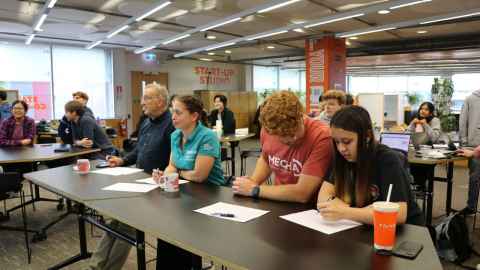MECHA’s Conceptual Design Competition unleashes blue sky thinking
15 May 2024
Students competed to create innovative ideas to solve engineering challenges, such as the lack of internet coverage in developing countries.

Undergraduate Engineering students recently flexed their skills in high-concept thinking, teamwork and communications through the annual MECHA Conceptual Design Competition.
The competition was held at Kura Matahuna Unleash Space, the innovation hub managed by the University of Auckland Business School’s Centre for Innovation and Entrepreneurship (CIE), and was organised by the Mechanical and Mechatronics Students Association (MECHA), which aims to empower students in the fields of mechanical and mechatronics engineering.
MECHA executive committee member Benjamin Mueggenburg says, “We strive to bridge the gap between academia and industry, all while championing diversity and inclusion.”
The Conceptual Design Competition provides students with an opportunity to work in teams and tackle an engineering challenge, combining engineering concepts and fundamental business methods that are important for developing innovative ideas. Students can further apply knowledge learnt in their undergraduate courses and apply it to develop a business case in a short period of time.
Competition judges included CIE staff member Peter Rachor, Hynds Entrepreneurial Teaching Fellow, alongside BECA Senior Systems Engineer Sasha Broxup, President of MECHA Luke Hynds and Director of Diversity at MECHA Sarina Todd.
Benjamin says, “Engineers need skills in assessing opportunities, developing and evaluating innovative ideas and converting them to effective business proposals. Unleash Space provides a perfect space for clubs like MECHA to run events that foster developing innovation skills through extra-curricular collaboration.”
A $500 prize pool was split among the first and second place winners.
Top four entries
First place – EEE
Second place – Endgame
- Team EEE – “Earth-Link”
An open-access satellite communications network that anyone can use. Low-cost and affordable by design, the concept looks to address the lack of widespread internet coverage in developing nations. - Team Endgame – “Satellite Equation”
Explored using satellites to make educational resources more accessible globally. - Team Kentucky Fried Circuit boards (KFC) – “FireFighters”
Explored providing a safer, more efficient method of visual information transmission to emergency responders and humanitarian efforts. - Team Oompa Loompas – “Desertification”
Aimed to address the destruction of habitable land due to deforestation and drought through alternative cloud seeding. Using the ice mined from asteroids, dropped over affected areas to reintroduce moisture into the atmosphere.
Learn more about the Mechanical and Mechatronics Student Association (MECHA).